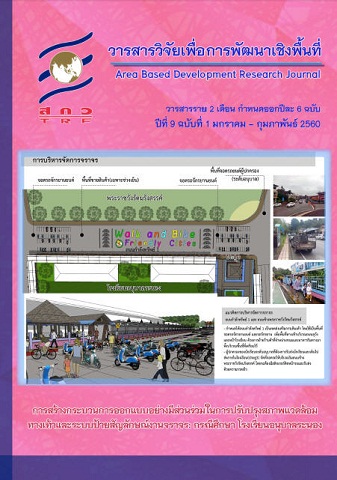การสร้างกระบวนการออกแบบอย่างมีส่วนร่วมในการปรับปรุงสภาพแวดล้อมทางเท้า และระบบป้ายสัญลักษณ์งานจราจร: กรณีศึกษา โรงเรียนอนุบาลระนอง
Main Article Content
Abstract
ประเทศไทยมีสถิติอุบัติเหตุทางถนนเพิ่มสูงขึ้นจาก 50,867 ครั้ง ในปี พ.ศ. 2549 เป็น 67,977 ครั้ง ในปี พ.ศ. 2558 โรงเรียนเป็นจุดเสี่ยงอันตรายที่สําคัญแห่งหนึ่ง เนื่องจากผู้ใช้ถนนส่วนใหญ่เป็นเด็กนักเรียน ที่ยังขาดความระมัดระวังและไม่ทราบความหมายของป้ายจราจร สอดคล้องกับหลายผลงานวิจัยที่พบว่า ปัจจัยด้านสภาพแวดล้อมทางเท้ามีส่วนสําคัญ และส่งผลต่อความปลอดภัย ปัญหาดังกล่าวจะทวีความรุนแรงมากขึ้นในเขตเมืองที่มีการจราจรหนาแน่นและโครงสร้างพื้นฐานไม่สมบูรณ์ งานวิจัยนี้มีวัตถุประสงค์เพื่อออกแบบปรับปรุงสภาพแวดล้อมทางเท้าและระบบป้ายสัญลักษณ์งานจราจรด้วยกระบวนการออกแบบอย่างมีส่วนร่วม มีโรงเรียนอนุบาลระนองเป็นพื้นที่ศึกษา กระบวนการศึกษาแบ่งออกเป็น 3 ขั้นตอน คือ การรับฟังแนวคิดและความต้องการ การพัฒนาแบบ และการนําแบบไปสู่การปฏิบัติ โดยจําแนกผู้ที่เกี่ยวข้อง คือ กลุ่มครูและนักเรียน กลุ่มประชาชนและหน่วยงานของรัฐในระดับท้องถิ่นกลุ่มนักวิชาการและหน่วยงานอิสระ และกลุ่มองค์กรเอกชน ผลการศึกษานํามาสู่การกําหนด “เขตส่งเสริมการเดินเท้า” การออกแบบปรับปรุงจุดจอดรับ-ส่ง ข้อค้นพบสําคัญ คือ การจัดตั้ง “หน่วยกล้าเดิน” (กลุ่มนักเรียนที่เดินทางมาโรงเรียนด้วยตนเอง) เป็นผู้ขับเคลื่อนการระบุปัญหาทางกายภาพ ผ่านการมีส่วนร่วมของหน่วยงาน เพื่อผลักดันงบประมาณ ซึ่งเป็นแนวทางที่มีแนวโน้มนําไปสู่ความสําเร็จ อย่างไรก็ตาม กระบวนการมีส่วนร่วมของงานวิจัยสามารถประยุกต์ใช้เพื่อพัฒนางานออกแบบให้สอดคล้องกับพฤติกรรมผู้ใช้ และความต้องการของท้องถิ่น โดยจําเป็นอย่างยิ่งที่ต้องศึกษาความเป็นไปได้ของโครงการควบคู่ไปด้วย
Participatory Design Process for Improving Pedestrian Environment and Traffic Sign System: A Case Study of Anuban Ranong School
Road accidents in Thailand tend to increase every year; increasing from 50,867 cases in 2006 to 67,977 cases in 2015. Nowadays, schools are the significant risk areas because most road users are students, they are less careful on the road and do not understand traffic signs. Several researches showed that the factor of the pedestrian environment affected to safety of people. This problem became more severe in the community with heavy traffic and incomplete infrastructure. The objective of this paper is to design the improved pedestrian environment and traffic signs with the participatory process with Anuban Ranong School as the studied area, three steps of the participatory design process were 1) focus groups with brainstorming methods composing of the conceptual design step, 2) design development step and 3) the implementation step. The samples of the study were 1) teachers and students, 2) local community and public organizations, 3) groups of academic lectures and independent scholars and 4) private companies. The recommendations from this study were brought to identify the “Promotion of Pedestrian Safety Zone” and design the improvement of kiss & ride and parking lots. The important finding was the establishment “Brave Walk Unit” (students walk from home to school without parents), the volunteer students who were driven mechanism to identify physical problems through the involvement of the agency with the authority to allocate or push forward the budget, which are the sign of possible achievement. Moreover, the participation process can be applied in other areas in order to get the design according to the user’s behavior and the local community’s need and possibilities for future research.
Article Details
Area Based Development Research Journal values copyright protection and licensing to safeguard author rights and facilitate the appropriate dissemination of research. Our policies ensure openness, accessibility, and attribution. Authors retain copyright ownership, and articles are published under a Creative Commons Attribution License (CC BY), allowing sharing, adaptation, and proper attribution. Authors have the freedom to publish under the CC BY license, granting broad reuse and distribution permissions. The journal supports posting articles on third-party repositories, adhering to institutional and funding restrictions. Author guidelines detail copyright and licensing requirements, empowering authors with knowledge about their rights and responsibilities. These policies cultivate an environment of collaboration, openness, and responsible sharing, benefiting authors and the research community while honoring intellectual property rights.
